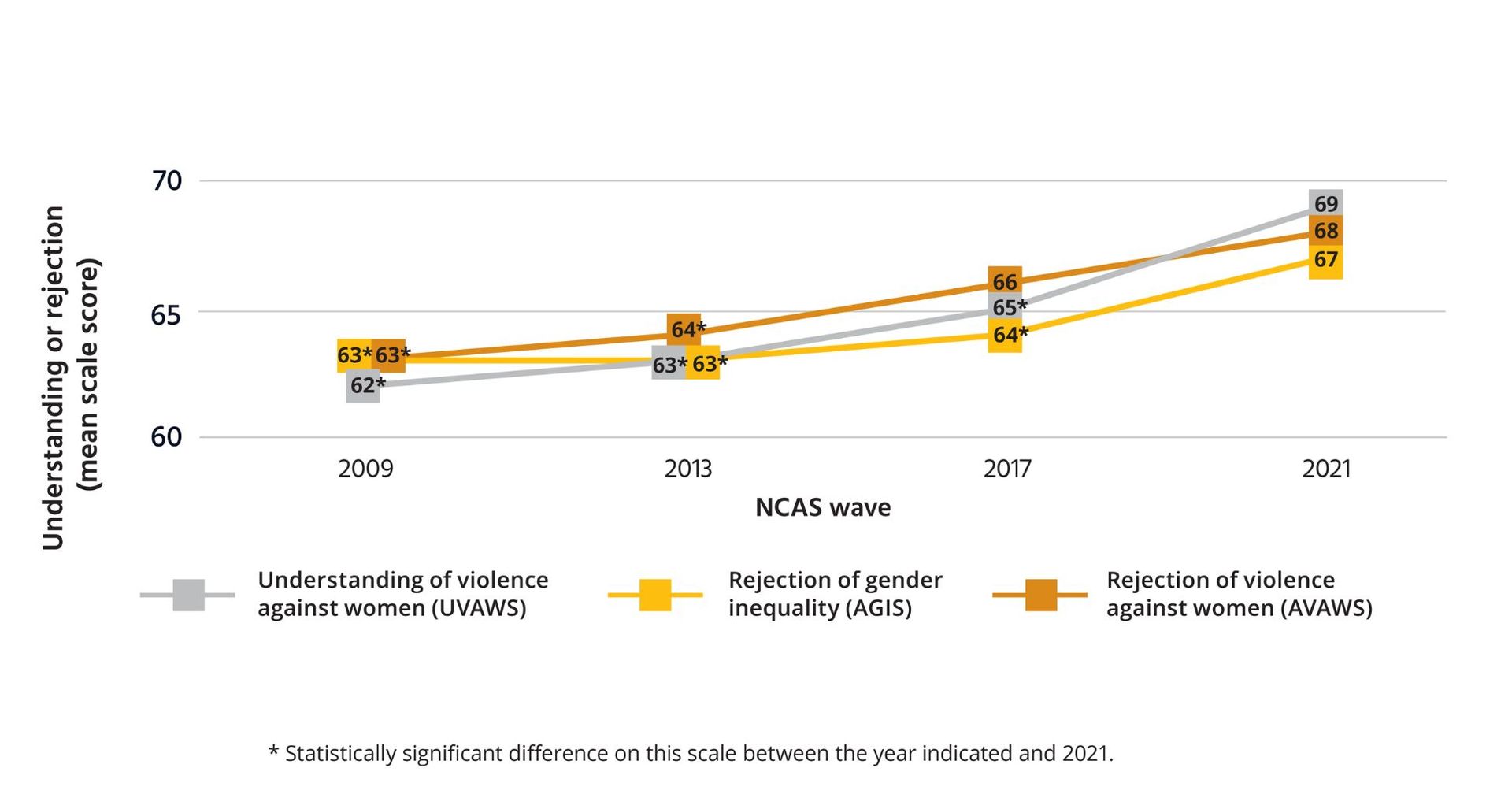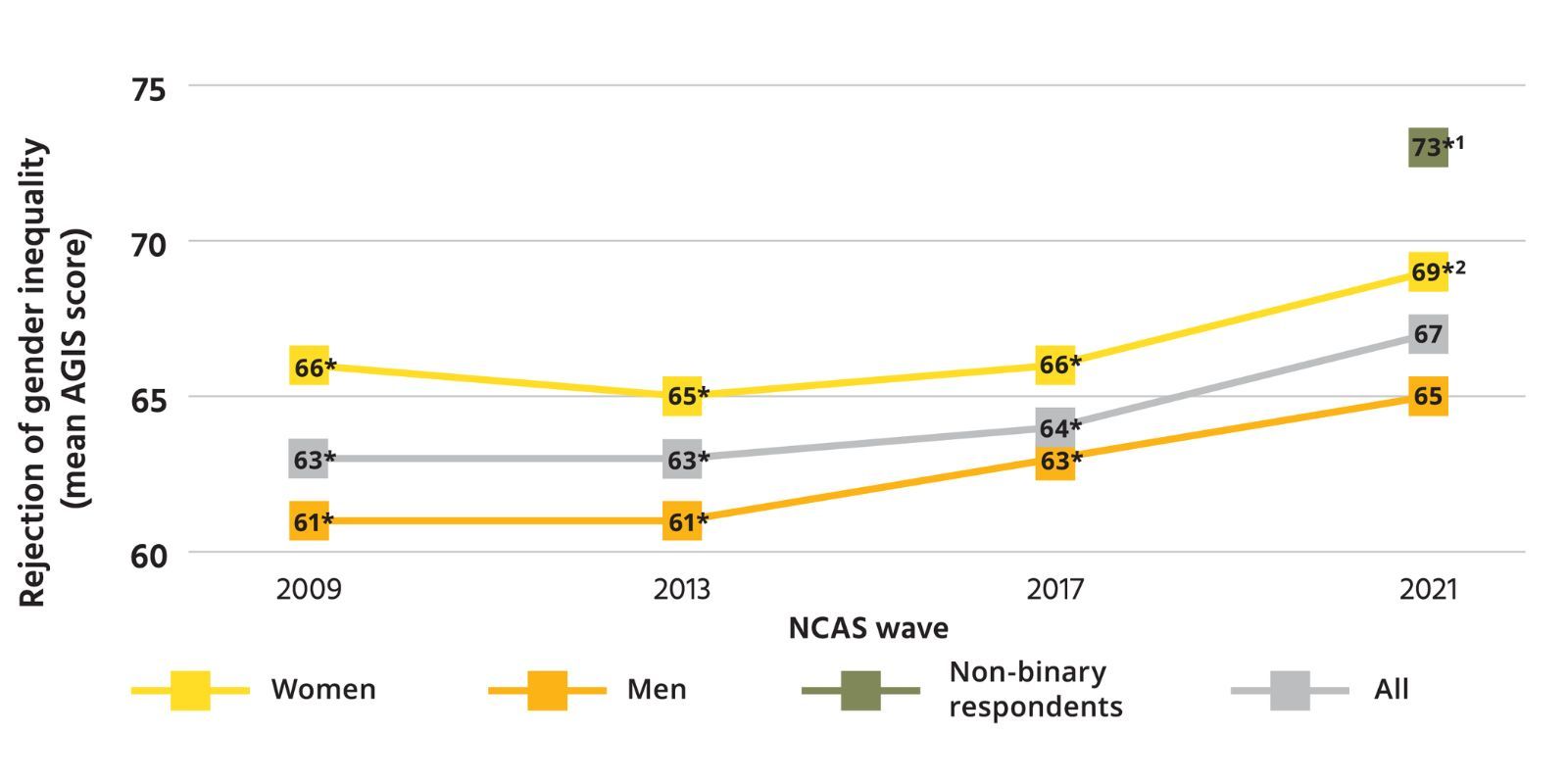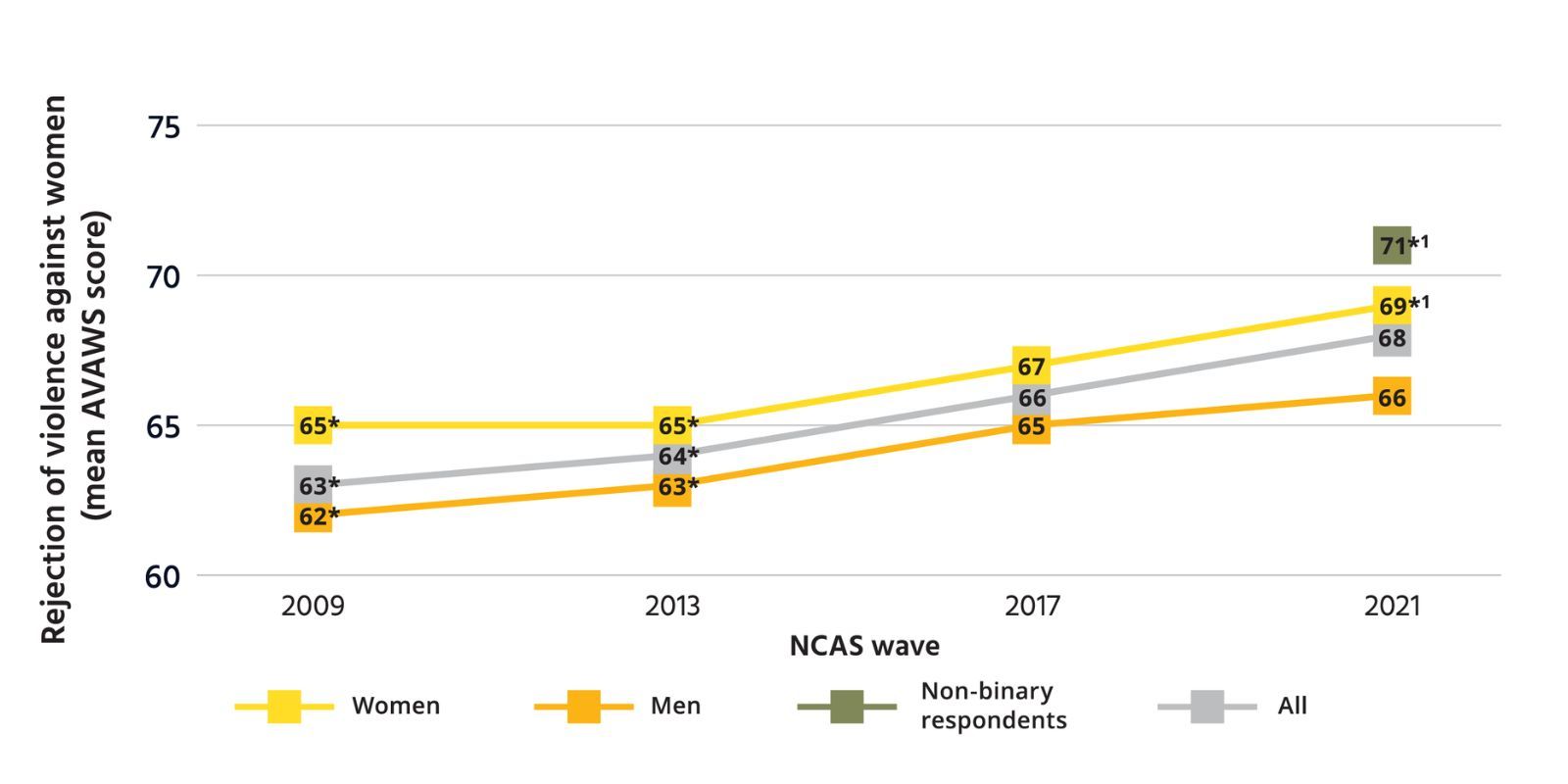Key findings for Australia
Key findings from Attitudes matter: The 2021 National Community Attitudes towards Violence against Women Survey (NCAS) are below.
For more information on the scales used in the NCAS, see Understanding the results.
For more findings and supporting data, download the Quick Guide to the 2021 NCAS.
You can view some of the key findings of the 2021 NCAS as infographics here.
Australians’ understanding and attitudes regarding violence against women and gender inequality have improved slowly but significantly over time.
- Between 2013 and 2021, there were significant improvements according to all NCAS scales measuring understanding and attitudes.
- Between 2017 and 2021, there were significant improvements in Australians’ understanding of violence against women and attitudinal rejection of gender inequality.
- While attitudinal rejection of sexual violence also improved significantly between 2017 and 2021, attitudinal rejection of domestic violence plateaued during this period.
- Nonetheless, Australians’ understanding of violence and their attitudes to both gender inequality and violence against women were at a comparable level in 2021.
Understanding of violence against women
The Understanding of Violence against Women Scale (UVAWS) measures whether Australians recognise certain behaviours as violence and how well they understand the gendered nature of violence. Higher scores on this scale indicate better understanding of the diverse forms of violence against women. An example of an item in the UVAWS is one that asks respondents whether harassment via repeated emails or text messages is a form of violence against women.
A majority of Australians do not think that violence against women occurs in all communities, including one’s own community.
Even though 91% of respondents agreed that violence against women is a problem in Australia, only 47% agreed that it is a problem in their own suburb or town.
Many Australians don’t understand that domestic violence is predominantly perpetrated by men against women.
41% of respondents believed that domestic violence is equally committed by both men and women, contrary to the evidence that men are the main perpetrators of this violence.
In 2021 compared to 2009 and 2013, significantly fewer respondents recognised that men are more likely to commit domestic violence: 57% in 2021 compared to 74% in 2009 and 71% in 2013.
Australians’ understanding of violence against women has significantly improved over time.
Women were significantly more likely than men to have “advanced” understanding of violence against women. Non-binary respondents had similar levels of understanding as women.
Respondents’ understanding of violence was significantly related to their demographic characteristics. However, this relationship was not very strong, suggesting that other factors are important in shaping understanding of violence.
Australians are less likely to recognise non-physical abuse as domestic violence.
Behaviours involving or threatening physical injury were most frequently recognised as “always” being forms of domestic violence:
- 82% of respondents recognised that slapping or pushing a partner to cause harm or fear is “always” domestic violence
- 92% of respondents recognised that scaring or controlling a partner by threatening family members is “always” domestic violence
Tactics of coercive control, including behaviours involving emotional abuse or financial abuse and behaviours that target aspects of a partner’s identity, beliefs or experience, are less frequently recognised as “always” being forms of domestic violence:
- Only 66% of respondents recognised that controlling a partner by forcing them to hide that they are transgender is “always” a form of domestic violence
- Only 66% of respondents believed that repeatedly criticising a partner to make them feel bad or useless is “always” domestic violence
Attitudes towards gender inequality
The Attitudes towards Gender Inequality Scale (AGIS) tells us how strongly Australians reject gender inequality in its different forms. The higher the score, the stronger the rejection of gender inequality in different contexts. For example, one item in the AGIS asks whether respondents agree or disagree that men generally make more capable bosses than women.
Some Australians hold attitudes that contribute to a broader climate of gender inequality. These include attitudes that condone limiting women’s personal autonomy in relationships, undermining women’s leadership in public life, normalising sexism, reinforcing rigid gender roles and denying women’s experiences of inequality.
Attitudes that limit women’s personal autonomy:
- 19% of respondents agreed that women prefer men to be in charge of relationships
Attitudes that undermine women’s leadership:
- 10% agreed that men make more capable bosses
Attitudes that normalise sexism:
- 15% agreed that there is no harm in sexist jokes
Attitudes that reinforce rigid gender roles:
- 6% agreed that women should not initiate sex when a couple starts dating
Attitudes that deny experiences of gender inequality:
- 41% of respondents agreed that many women mistakenly interpret innocent remarks as sexist
Attitudes towards violence against women
The Attitudes towards Violence against Women Scale (AVAWS) measures how strongly respondents reject problematic attitudes regarding violence against women. The higher the score on the AVAWS, the stronger the rejection of incorrect myths, or problematic beliefs concerning violence against women. For example, one item in this scale asks whether respondents agree or disagree that a woman can make a man so angry that he hits her when he didn’t mean to.
Harmful myths and stereotypes about violence against women persist. Women are still being blamed for causing their own victimisation or for lying about their experiences, while men are being excused for their violent behaviour.
19% of respondents agreed that sometimes a woman can make a man so angry that he hits her when he didn’t mean to.
23% of respondents agreed that much of what is called domestic
violence is a normal reaction to day-to-day stress and frustration.
34% of respondents agreed that it is common for sexual assault
accusations to be used as a way of getting back at men.
37% of respondents agreed that women going through custody battles often make up or exaggerate claims of domestic violence to gain tactical advantage in their case.
Australians’ attitudes towards domestic violence did not improve between 2017 and 2021. Misperceptions about domestic violence persist, including that perpetration can be justified, that it should be handled privately within the family and that victims and survivors are partly to blame.
Nearly one quarter (23%) of respondents agreed that much of what is called domestic violence is a normal reaction to day-to-day stress and frustration.
More than 1 in 10 respondents (12%) agreed that domestic violence is a private matter that should be handled in the family.
1 in 4 respondents agreed that a woman who does not leave an abusive partner is partly responsible for the abuse continuing.
Australians mostly hold attitudes that reject violence against women and this rejection has significantly improved since 2013.
However, there was no significant improvement in overall attitudes towards violence against women between 2017 and 2021, largely reflecting a plateauing of attitudinal rejection of domestic violence despite an improvement in attitudinal rejection of sexual violence since 2017.
Non-binary respondents and women were significantly more likely than men to have “advanced” attitudinal rejection of violence against women.





